
Moth larvae are the very pests that spoil clothes, “cut” fur and leave ugly bald spots on almost any natural textile. Butterfly moths cannot spoil clothes: their mouth apparatus is not developed at all, and they do not feed at all during their entire adult life. However, it is the butterflies that lay eggs, from which the progeny are rather quickly hatching. And each moth larva is, one can say, a few more new holes in woolen clothes or fur.
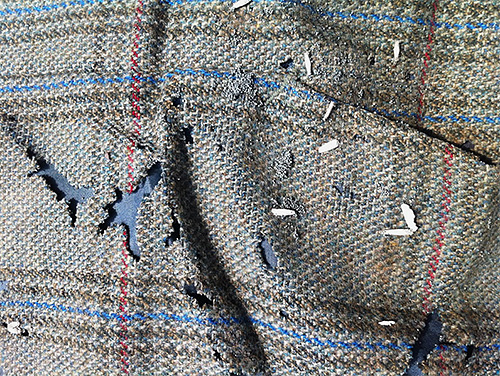
It is interesting
The myth is that the females of the moth do not have wings. They are all winged, although their bodies for flight are slightly smaller than those of the males. Another thing is that the females practically do not use their wings, and the butterflies flying around the room are, indeed, exclusively males.
The larva of the home moth can spoil not only clothes.Moles capable of living and breeding in a person’s home are hundreds of species, and each of them has its own food specialization. The larvae of the home moth can eat fur and tissues, flour, cereals, dried fruit, bread, nuts, pet food - almost any organic products.
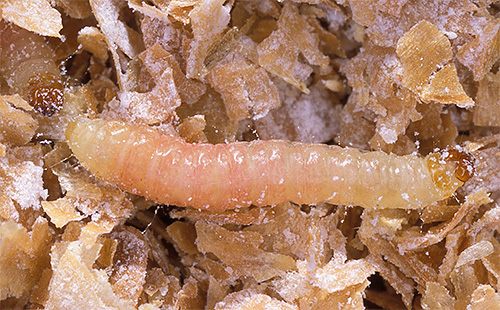
But at the same time, the larvae of moths in photos and live look all on one person, and only an experienced view of a professional entomologist will be able to find the difference between the caterpillars of moths of different species.
Appearance and characteristics of moth larvae
Live and pictured moth larvae are small white caterpillars or with a slight yellow tinge. Whatever species the mole belongs to, its larvae have powerful gnawing jaws and a clearly distinguishable brown head. The photo below shows the larva of the clothes moth:
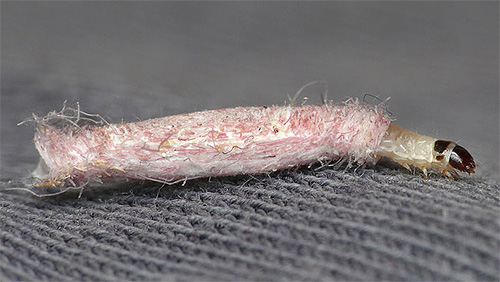

In most species of moths, the larvae look like small worms, but this comparison is not entirely correct - real worms do not have limbs, and the moth caterpillar, like any other insect, has six pairs of tiny legs.
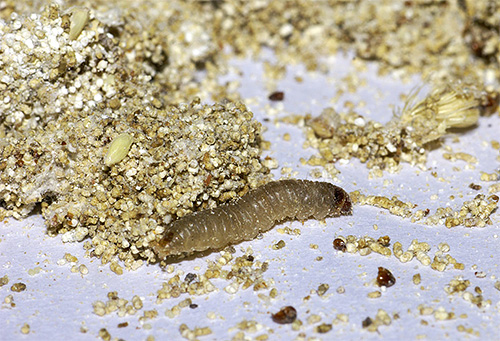
It is interesting
In the body of the moth caterpillar there are more individual muscles than in the human body.This allows the pest to move actively and eat efficiently.
The larva of the food moth looks almost the same as the larva of the clothes moth. However, the caterpillar of the pest of the pest will never be fed in flour or croup, and vice versa: food moth, for example, there are several species of moths, the caterpillars of which are not able to feed on textiles. Below in the photo you can see what the larvae of the barn food moth look like - a known food pest:

It is characteristic for clothes, furniture, carpet and fur moths that their larvae make a cover for themselves - a small cocoon of their own silk-like substance and remnants of damaged tissues, which the caterpillar puts on itself and with which it moves for short distances. And at the furniture moth, the larva even makes for itself a whole house in the form of a tunnel of silk, food debris and excrement:
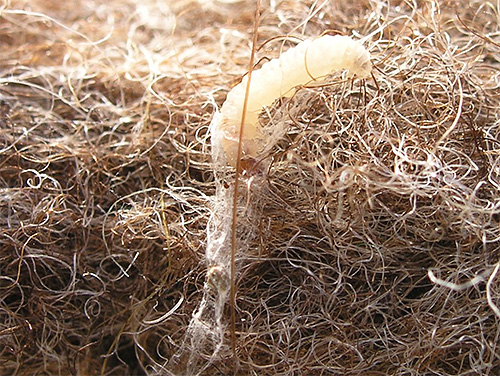
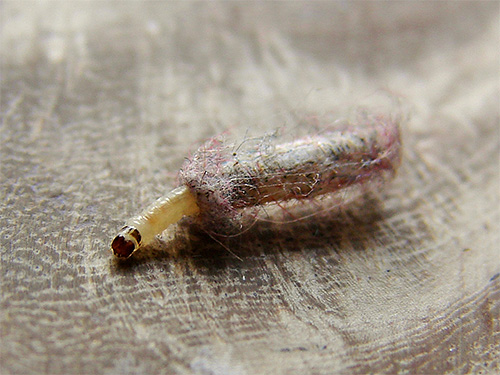
Similar cocoons create food moth larvae. In the photo - flour, spoiled by ognevka. Lumps are visible, which are covered with flour cocoons:


On a note
The larva of carpet or furniture moth differs very well from the kozheed larva. Any larva kozheeda covered with long hairs and usually has a dark skin color. Next on the photo is presented the kozheed larva, and below is the larva of the carpet moth.In addition, kozheedov larvae are well distinguished by the “temperament”: they are very mobile and crawl quickly.
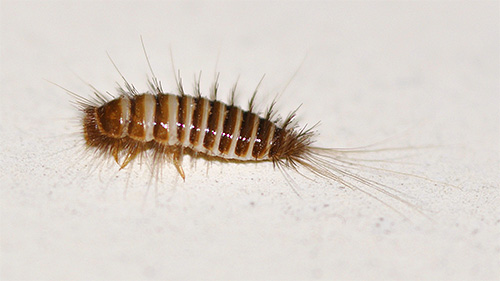
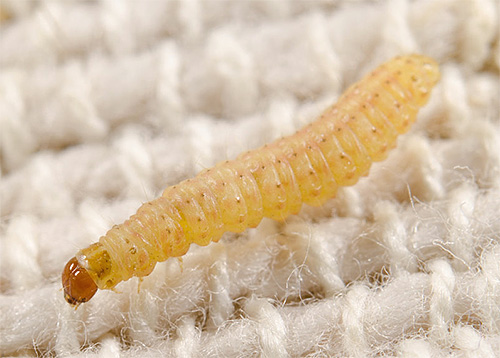
Growth and lifestyle of the larvae
Terms of development of larvae of different species are different and depend not only on the biology of the species, but also on their habitat conditions. The optimum temperature for the development of larvae of clothes and furniture moths is 23-25 ° C. Under these conditions, the development of moth larvae in a fur coat lasts about 90 days, and the total cycle from egg to egg lasts up to six months.
It is interesting
At a temperature of about 30 ° C, the larva of the clothes moth with a normal diet has time to develop in two months, and at a temperature of 13 ° C it will take about 190 days.
At temperatures below 13 ° C and above 30 ° C, the eggs of the clothes moth do not develop, and the larvae die. A larva of the food moth can develop at approximately the same temperature ranges, but its growth occurs much faster due to its greater nutritional value. At a sufficiently high temperature, the larva of the barn moth pupates within a month after it leaves the egg. During its development, the moth caterpillar survives 4 molts. Therefore, it is customary among entomologists to talk about the five instars of the larva. In the photo below - the last moth caterpillar:
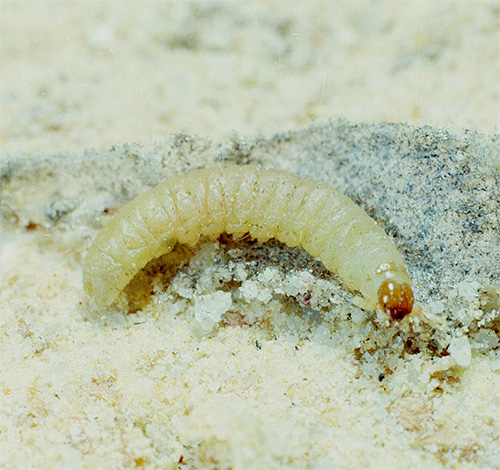

Moth larvae are inactive and rarely move over long distances. Females lay their eggs either on the food itself for their offspring, or in the immediate vicinity of it, and after hatching, the larvae can only eat and grow. At the same time, the youngest larvae can crawl away to a sufficiently large distance from the hatching site.
It is interesting
Copper moth larvae are typical pests. Many of them, moving along the fur, simply gnaw the hairs, but do not eat them, and as a result leave noticeable tracks on the fur clothing.
The photo below shows a larva with a cap and an adult butterfly on a cloth moth on a piece of cloth.

Larvae of almost all species of moth try to avoid lighted surfaces. Only in some moths, the caterpillars are selected from food places to pupate in open space. The larvae of the moths on the ceiling are the caterpillars of the moths. In the photo below - moth larvae in the rump:
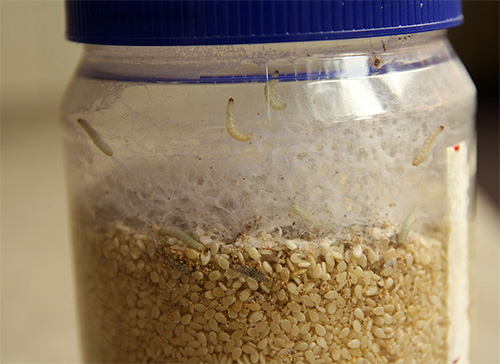
Moth caterpillar feeding
Larvae of different types of moles can eat a huge assortment of food. In nature, these insects feed on mammals' hair and feathers of birds in their nests, can develop on the skins of deceased animals, affect cereals, fruits, nuts, berries and vegetables.
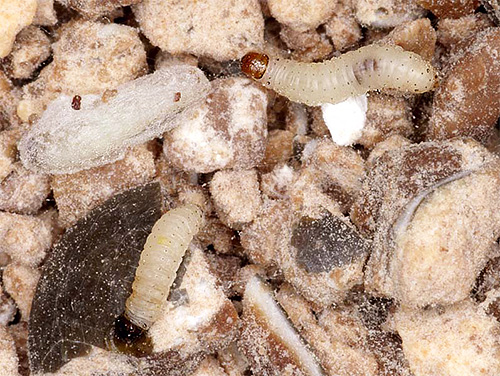
However, human dwellings are preferable for these insects due to the constant microclimate and the constant availability of food. That is why the larvae of the home moth are found on food in much larger quantities than in nature. Pests are those types of moths that do not harm things or furniture. For example, the larvae of the bee moth eat wax combs, honey and perga. And the larvae of the moth, parasitic in the homes of ants, can eat the larvae of ants themselves.
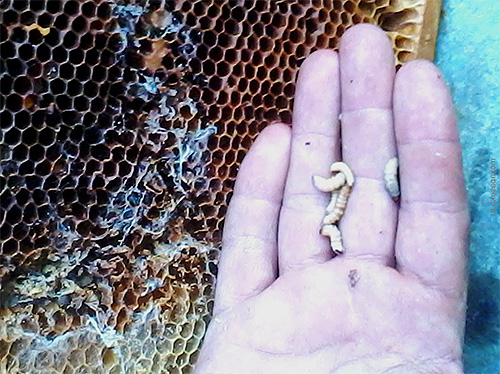
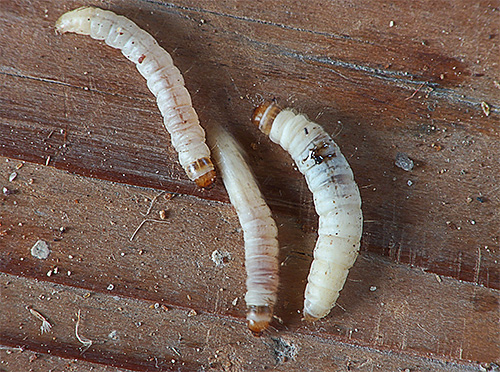
Moreover, most butterflies of this group are not distinguished by a narrow specialization. The larvae of each type of moth can eat almost any food, and the same clothes moth can easily switch from cotton to wool and vice versa. On the photo - holes in a sweater, which left the larvae of the home moth:
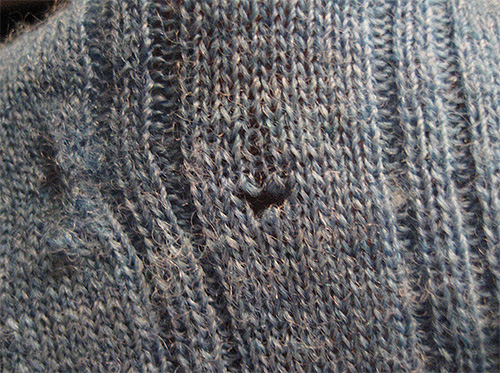
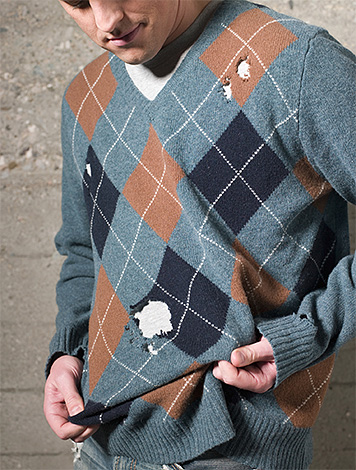
Moreover, there are cases when moth larvae spoiled even semi-synthetic garments.
Moth larvae as the main pests of clothing
Clothes, furniture upholstery, carpets are enough convenient food for moth larvae. If the materials are made of natural fabric, it does not matter if it is wool or cotton, the stomach of any larva will digest it.In addition, the oldest things are preferable for caterpillars, since the fabric and the pile on them are more easily cracked by the caterpillar's jaws. Each caterpillar is able to eat quite a bit of tissue. For example, minor damage to carpets may be outwardly and not noticeable. But because of the fairly large number of larvae in each brood, they almost simultaneously leave several injuries, already well distinguishable.
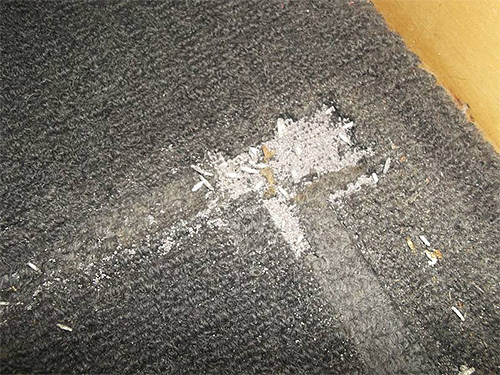
And the garments themselves, on which a characteristic hole appeared, are no longer considered toes. A moth is distributed between houses and apartments, usually by a person himself. These butterflies are not able to fly over long distances, and the owner of the apartment usually brings the larvae on the purchased clothes to the house, and already these larvae give rise to a new micropopulation. This is especially true for clothing from second-hand and old carpets from relatives, on which the larvae of the carpet moth travel. The larvae of the food moth, respectively, "travel" with food.
Fight with moth larvae in the house
It is rather difficult to fight with moth larvae, although there is nothing particularly cunning about it.The larvae of clothes and furniture moths can be easily removed by treating clothes, furniture and carpets with special insecticidal aerosols. After that, things are washed, and the furniture is thoroughly wiped with a damp cloth.
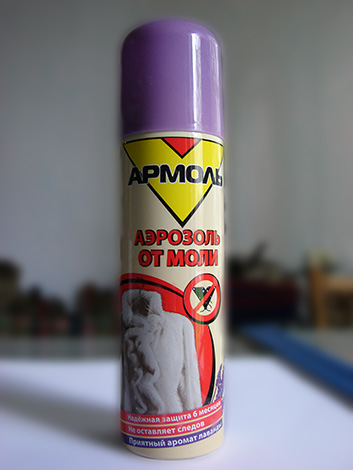
The pest larvae usually loosely adhere to clothing, and therefore, when shaking it for the most part, it is poured onto the floor. They will die when things get warm in the sun at temperatures above 35 ° C. In the optimal case, the larvae of moths should be removed by operations in the following sequence:
- Shaking out all the clothes carefully.
- Warming up clothes in the sun or washing them in a washing machine at a temperature of over 50 ° C - it is the temperature that is most effective to kill the moth larvae
- After treating clothes and cabinets with aerosol insecticides (Antimol, Armol, Raptor from moths, etc.)
- Only after the complete destruction of the moth to use repellents - sections from moths, lavender, essential oils, fumigators.

It is more difficult to fight food moths. It is impossible to destroy the larvae of the food moth with insecticides at all (the poison will get into the products), you can only:
- Throw out all the products in which there are larvae.
- To destroy flying butterflies mechanically (with a slipper or fly swatter).
- Treat cabinets and cabinets with aerosol insecticides.
- Buy further products in quantities that are eaten in a week.
Effectively preventing moths from getting into the apartment is washing up new things and careful checking of the food they buy. In another way, they have not yet learned how to deal with moth larvae due to their universality and ability to live even on extremely meager rations. However, these methods will already be enough to protect your home from harmful butterflies and their caterpillars. It is important to remember that mole is not only a pest. Even her caterpillars man learned to use for their own benefit. For example, the burdock moth larva is an excellent bait for winter fishing, the wax moth caterpillar is almost an ideal live food for exotic frogs in terrariums, and the tincture from wax moth larvae known as a remedy against tuberculosis and stroke.
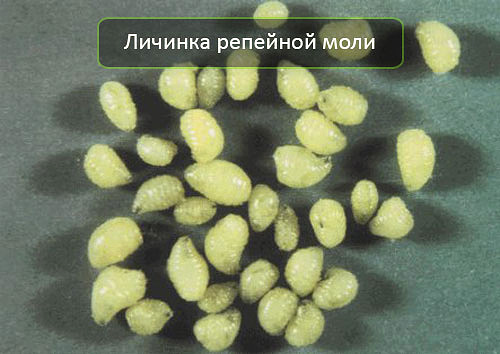
In general, in nature, a mole is a necessary participant in many biocenoses, and therefore it is impossible to consider a mole as totally harmful, and it should be destroyed only when it represents a danger to the sanitary condition of the home.
Interesting video: transformation of the larva of the moth into a butterfly (accelerated shooting)
And so, actually, look like the larvae of the clothes moth in their caps

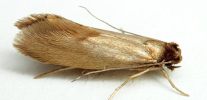
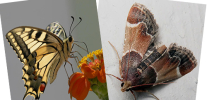
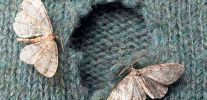
Many thanks to the authors for the material - a lot of information, clearly, systematically, accessible! Sincerely, Victoria, entomologist.
How I got these creatures already. All washed, washed. 3 months was not, open the closet - again b * b. Madden.
Good evening, you got rid of the moth ?! If so, tell me how? They already really got me, things spoil and fly.
Informative, detailed and useful. Thank you very much!
Very expanded knowledge! Thank!
It was very interesting. Thank you so much!
cool
Please tell me if the food moth larvae have a circulatory system or does it only have moth moths?
I am enraged by these larvae.
Some things can be otparivatel steam to kill the larvae, and even walk through the closet in the corners. A very useful article, especially the fact that the males fly and we chase them around the apartment, but at this time the females lay eggs in our things.
My strength is no more! How did they get me! I do not know how to deal with them! Velcro, lavender traps, citrus peels, naphthalene, moth spray. And all to no purpose.Share your experience of getting rid of these vile creatures.
It is one thing - on clothes, and another - when she is multiplying in a sofa. Sleep like that, and then for you this abomination crawls. Unpleasant, I tell you!
If someone could get rid of, for God's sake, share how? Every 3 months, new creatures fly!
As a child, my grandmother soaked the newspaper with kerosene and shook the rug with them. She said that from moth.
They also say that a thing in the microwave (only without metal parts) is irradiated so that any water boils, including in the larvae and eggs of any parasites.